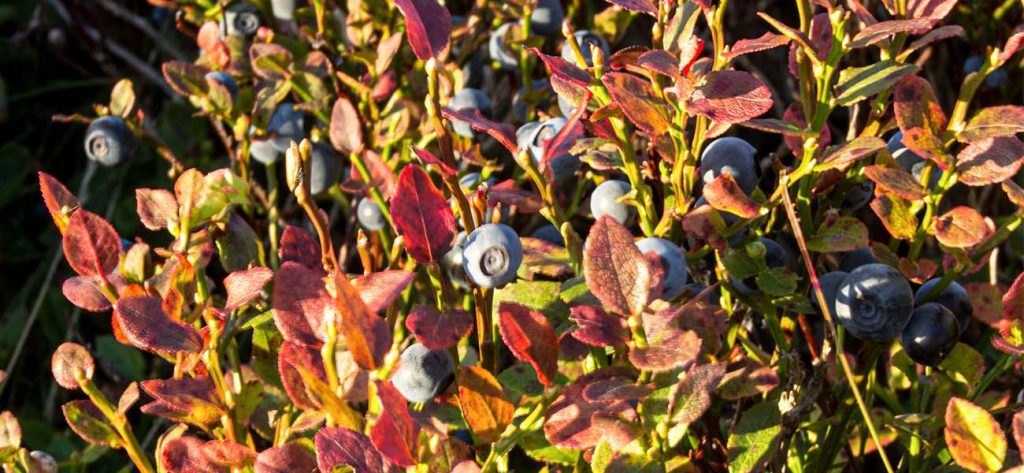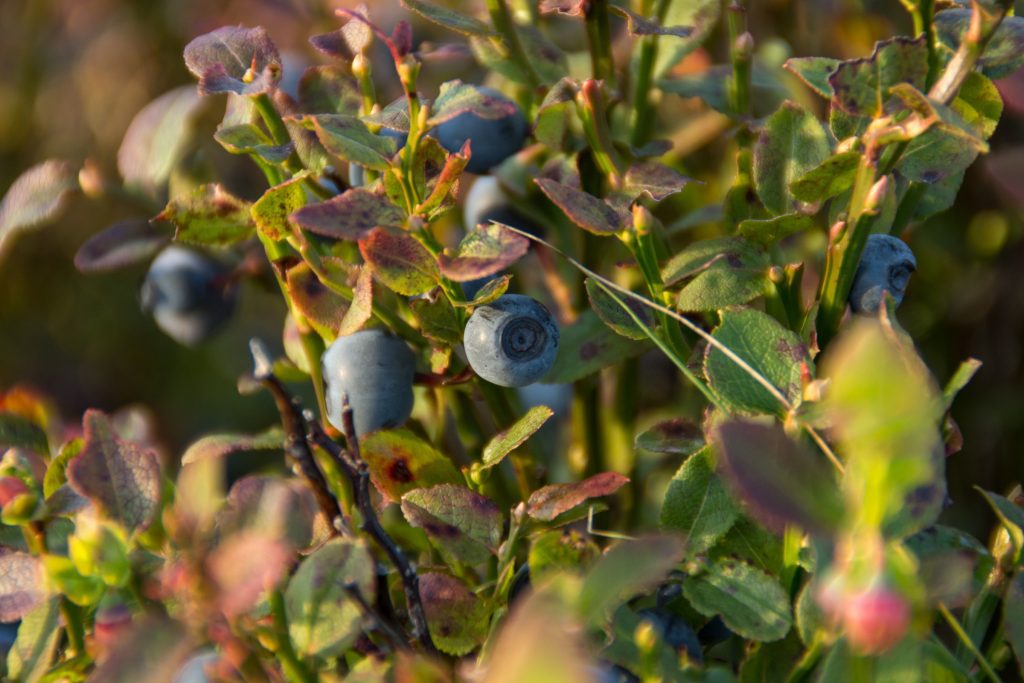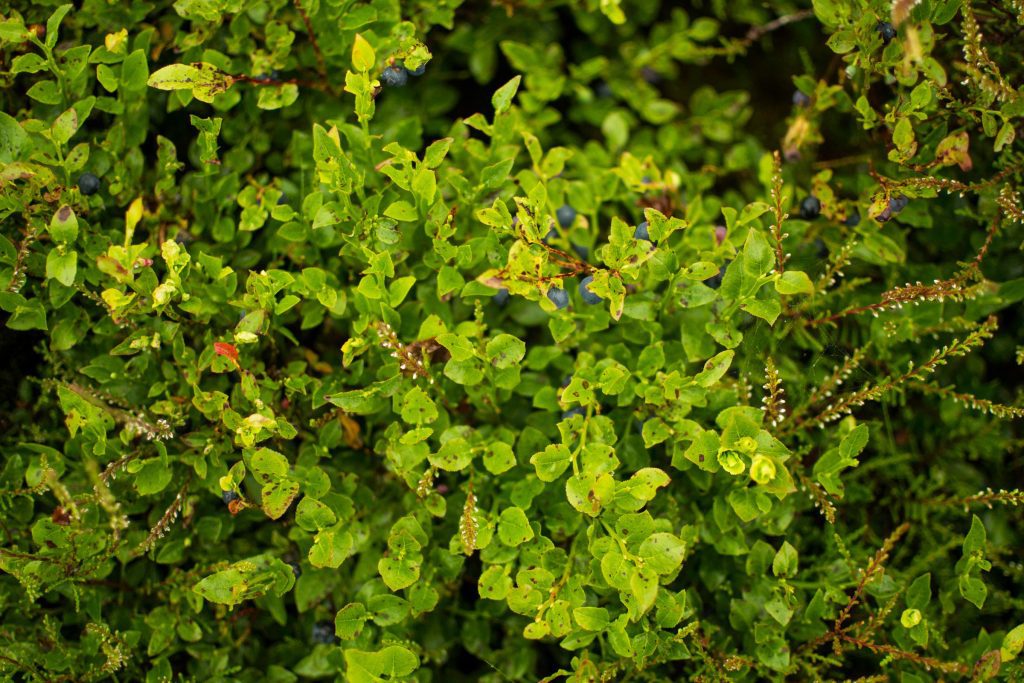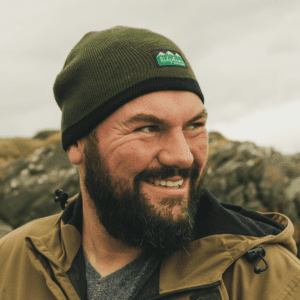
Bilberry / Vaccinium myrtillus
15th August 2018
Alternative names: Blaeberry, Whortleberry, Wimberry, Llus, Urts, Hurtleberry, Huckleberry, Fraughan (Fraochán), European Blueberry
From early August onwards any of my work in the mountains of England, Wales and Scotland is often accompanied by the action of grazing on these tiny purple blobs as I work my way through the heather and scrub. Bilberries (the most-used common name, but lots of regional variations exist – see above) are easy to find and identify, and can be eaten straight from the bush with no problems and few misidentification worries. The fruits can be picked easily by hand and turned into a variety of jams, pies and other fruit preserves.
Where do Bilberries grow?
Within the UK you will find Bilberry bushes growing amongst heather and gorse plants on upland acidic soils. I’ve found them on pretty much every UK mountain I have climbed or visited, even if the species was only represented by a few straggly bushes clinging on between some rocks, away from the relentless grazing of sheep or deer. You may also find them growing in clearings and glades under conifers on uplands – either as a holdfast from the previous cultivation of that piece of land (i.e. they were there before the trees were planted in the last 150yrs or so) or transplanted in some form from neighbouring hillsides. Not far from our offices is an open hill sticking out above Clocaenog forest, known as Pincyn Llys. The prominent feature is a tall stone obelisk/monument erected by Lord Bagot in 1830 to commemorate the planting of the first trees of what became the commercial plantations of Clocaenog Forest. A later inscription on the side of the monument marks the re-planting and extension of the forest by the Forestry Commission following intensive felling for pit props and trench materials during the First World War. “Llys” in Welsh means “court” – but there are many who think that the name Pincyn Llys is a modern mistranslation/misnaming of this hilltop. The open clearing on the summit is absolutely COVERED in Bilberry bushes, and there is a lot to suggest that there have been Bilberries growing here for a long time. So given that the Welsh for Bilberry is “Llus” – should the 413m high hill overlooking Bontuchel and Clocaenog actually be called ‘Pincyn Llus’?
Are Bilberries edible?
Bilberries are edible straight from the bush (assuming you’ve made a good and positive identification) and can be safely eaten raw in most cases. Some care is needed when picking them as they have a tendency to pop easily. Stained fingers and clothing often result from a Bilberry foraging session. I use a berry comb or Peigne to gather them (see the video below). There are two potential issues with using this device for harvesting berries though – they can strip leaves from the branches if not used carefully, and they are almost TOO efficient at harvesting berries. I managed to harvest about 4kg in less than an hour this month, although that was probably less than 1% of what was in that immediate area. I would recommend that they are only used sparingly in areas where Bilberries are abundant, and your foraging activity has minimal impact.
How to identify Bilberries
Bilberries look like smaller, less substantial blueberries (it’s no coincidence, they’re closely related). The berries are obvious and prominent from August until early October for most of the UK, but can often be found earlier in some places. The stringy, woody stems of Bilberry are quite distinctive too – they’re often the bush on the side of a UK mountain that isn’t heather or gorse. The flowers are small and pale purple/pink. The leaves are slightly oval, and have tiny serrations around the edge.
Potential dangers and misidentification
Bilberries are a fairly safe foraging target as they grow in places where few other fruit bushes do (in the UK at least) and the only fruit you are possibly likely to come across in the same area are Blackberries. If you discount the rest of the plant and look only at the fruit itself then it’s conceivable that you may confuse them with the fruits of White Bryony (Bryonia alba) – but it’s probably quite unlikely.



A note of caution
Foraging and hunting for wild food is a potentially hazardous activity. Whilst we try to make sure these wild food guides are as accurate as possible there is ALWAYS the possibility of misidentifying a plant or other item and the descriptions given might also apply to similar toxic plants. Common names cannot be relied upon as they change from region to region, and there are some similar names for very different plants.
You should always be confident of the identification of a plant, fungus or lichen BEFORE you touch it and especially before you put it anywhere near your mouth. The best way to do that is by checking with a good wild flower key or identification book, and ideally cross-referencing between more than one book. We have a blog post on some of the foraging guide books that we recommend HERE. We also deliver foraging and wild foods training through private bookings and our Academy.
A Mountain Leader with over a decade of experience across the UK and overseas, Richard is our Lead Instructor and a partner in Original Outdoors. He is a specialist in temperate wilderness skills and the wild foods of the British Isles, and also works as a consultant for various brands and organisations. Richard lives in North Wales.
A Life more Wild.
A Life More Wild is the philosophy which underpins everything we do.
It encompasses practical skills, personal development, community learning and a journey to live more intentionally.

